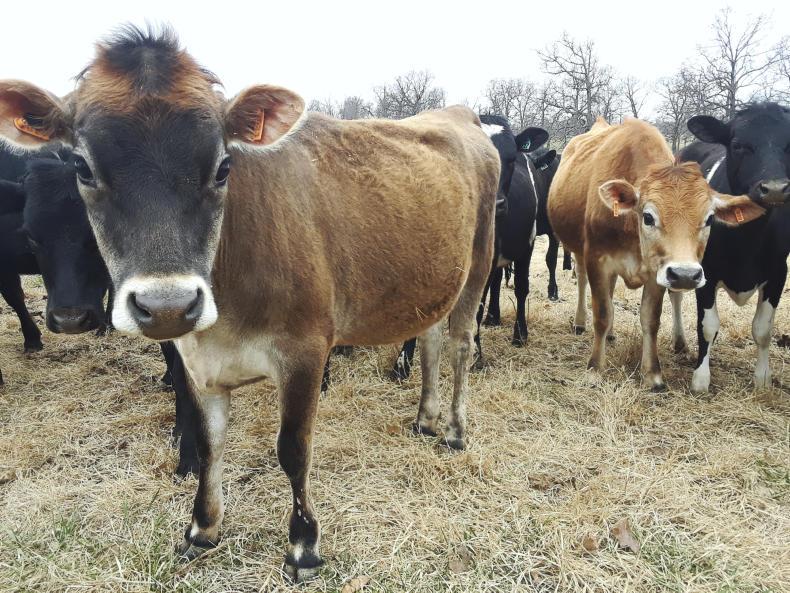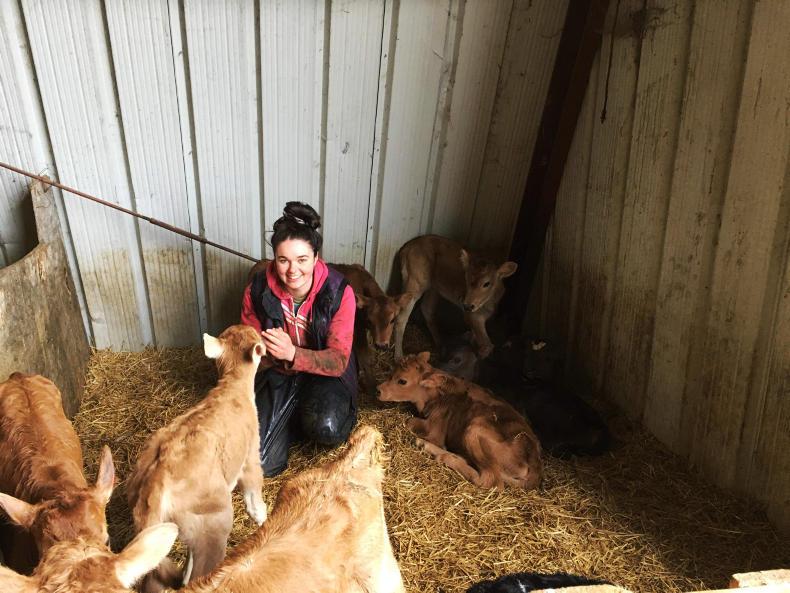Hi, my name is Mairead Fox. I’m a third year student at UCD, studying Animal and Crop Production. As part of my professional work experience I decided to travel to Emerald Dairies in southwest Missouri to experience a spring-calving, grass-based dairy system.
Originating from a dairy farm in Rosemount, Co Westmeath, I have experience with regards to the dairy system. However, I was eager to experience a larger system away from home, renowned for its low cost implementations and the management systems involved.
In some ways it was what I had expected, but in other ways it was totally different.

Scale and calving
On arrival I was surprised by the sheer scale of the farm, consisting of a milking platform of 356ha.
In total, a sizable herd of 1,060 Jersey crossbred cows were planned to calve down starting 6 February.
By day 11 half of the herd was already calved, with an average of 30 calves born a day during three consecutive weeks.
As cows are grazed outdoors all year round, as soon as cows begin to calve my duties included carrying out calf checks every couple of hours (both day and night). As soon as calves are born they are collected, brought inside, sprayed with iodine, tagged and tubed with three litres of colostrum, which is vital in the first two hours of life.
The normal daily routine for calves consists of once-a-day feeding. At first it surprised me that calves were only fed once a day, however after two months of working here I realised it works great, as calves are achieving target weights and thriving well.
Calves are fed four litres of milk and concentrates are made available from an early age.
They are then reduced to three and two litres daily respectively, and subsequently weaned at eight weeks of age and consuming over 1.5kg of concentrates.
Milking
Apart from feeding calves, other duties include milking. Punctuality is key when it comes to early starts on the farm.
The milking commences with cups on at 5:30am in the two 40-unit herringbone parlours consisting of batch feeders and a large circular collecting yard, complete with an electric backing gate.
Adjusting to the early starts was easier than expected, as they seemed a bit daunting at the beginning. Freshly calved cows are drafted daily from the springer herd and join the colostrum herd.

The colostrum herd is milked separately twice daily and thereafter drafted into the milking herd once they pass the California Milk Test, which proves their milk is clear to enter the bulk tank.
Cows are currently on a 30-day rotation on the east farm at 3.01 LU/ha, averaging 22 litres at 5.29% butterfat and 4.13% protein.
Social
Outside the farm I meet up with fellow UCD students who are also based on farms in the area. Whether it’s going for food or a couple of drinks, it’s good to catch-up and share experiences.
We also hope to travel at the end of our placement to different parts of America to truly grasp the whole experience of being away from home, seeing different cultures and meeting new people.

Since starting my placement, just over two months ago, I can safely say working on the farm here in Missouri has most definitely opened my eyes to the large-scale, low-input, grass-based system.
I look forward to the upcoming breeding season to further my knowledge on animal breeding and reproduction. I also look forward to sending an update in a few weeks’ time on my experiences.
Read more
Student blog: working on a 1,250 head dairy herd in New Zealand/a>
Student blog: milking on a NZ farm where a helicopter spreads fertiliser
Hi, my name is Mairead Fox. I’m a third year student at UCD, studying Animal and Crop Production. As part of my professional work experience I decided to travel to Emerald Dairies in southwest Missouri to experience a spring-calving, grass-based dairy system.
Originating from a dairy farm in Rosemount, Co Westmeath, I have experience with regards to the dairy system. However, I was eager to experience a larger system away from home, renowned for its low cost implementations and the management systems involved.
In some ways it was what I had expected, but in other ways it was totally different.

Scale and calving
On arrival I was surprised by the sheer scale of the farm, consisting of a milking platform of 356ha.
In total, a sizable herd of 1,060 Jersey crossbred cows were planned to calve down starting 6 February.
By day 11 half of the herd was already calved, with an average of 30 calves born a day during three consecutive weeks.
As cows are grazed outdoors all year round, as soon as cows begin to calve my duties included carrying out calf checks every couple of hours (both day and night). As soon as calves are born they are collected, brought inside, sprayed with iodine, tagged and tubed with three litres of colostrum, which is vital in the first two hours of life.
The normal daily routine for calves consists of once-a-day feeding. At first it surprised me that calves were only fed once a day, however after two months of working here I realised it works great, as calves are achieving target weights and thriving well.
Calves are fed four litres of milk and concentrates are made available from an early age.
They are then reduced to three and two litres daily respectively, and subsequently weaned at eight weeks of age and consuming over 1.5kg of concentrates.
Milking
Apart from feeding calves, other duties include milking. Punctuality is key when it comes to early starts on the farm.
The milking commences with cups on at 5:30am in the two 40-unit herringbone parlours consisting of batch feeders and a large circular collecting yard, complete with an electric backing gate.
Adjusting to the early starts was easier than expected, as they seemed a bit daunting at the beginning. Freshly calved cows are drafted daily from the springer herd and join the colostrum herd.

The colostrum herd is milked separately twice daily and thereafter drafted into the milking herd once they pass the California Milk Test, which proves their milk is clear to enter the bulk tank.
Cows are currently on a 30-day rotation on the east farm at 3.01 LU/ha, averaging 22 litres at 5.29% butterfat and 4.13% protein.
Social
Outside the farm I meet up with fellow UCD students who are also based on farms in the area. Whether it’s going for food or a couple of drinks, it’s good to catch-up and share experiences.
We also hope to travel at the end of our placement to different parts of America to truly grasp the whole experience of being away from home, seeing different cultures and meeting new people.

Since starting my placement, just over two months ago, I can safely say working on the farm here in Missouri has most definitely opened my eyes to the large-scale, low-input, grass-based system.
I look forward to the upcoming breeding season to further my knowledge on animal breeding and reproduction. I also look forward to sending an update in a few weeks’ time on my experiences.
Read more
Student blog: working on a 1,250 head dairy herd in New Zealand/a>
Student blog: milking on a NZ farm where a helicopter spreads fertiliser









 This is a subscriber-only article
This is a subscriber-only article















SHARING OPTIONS: